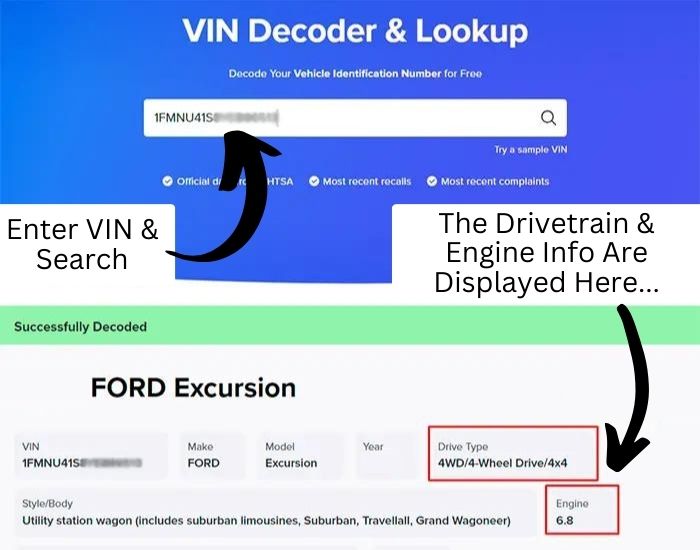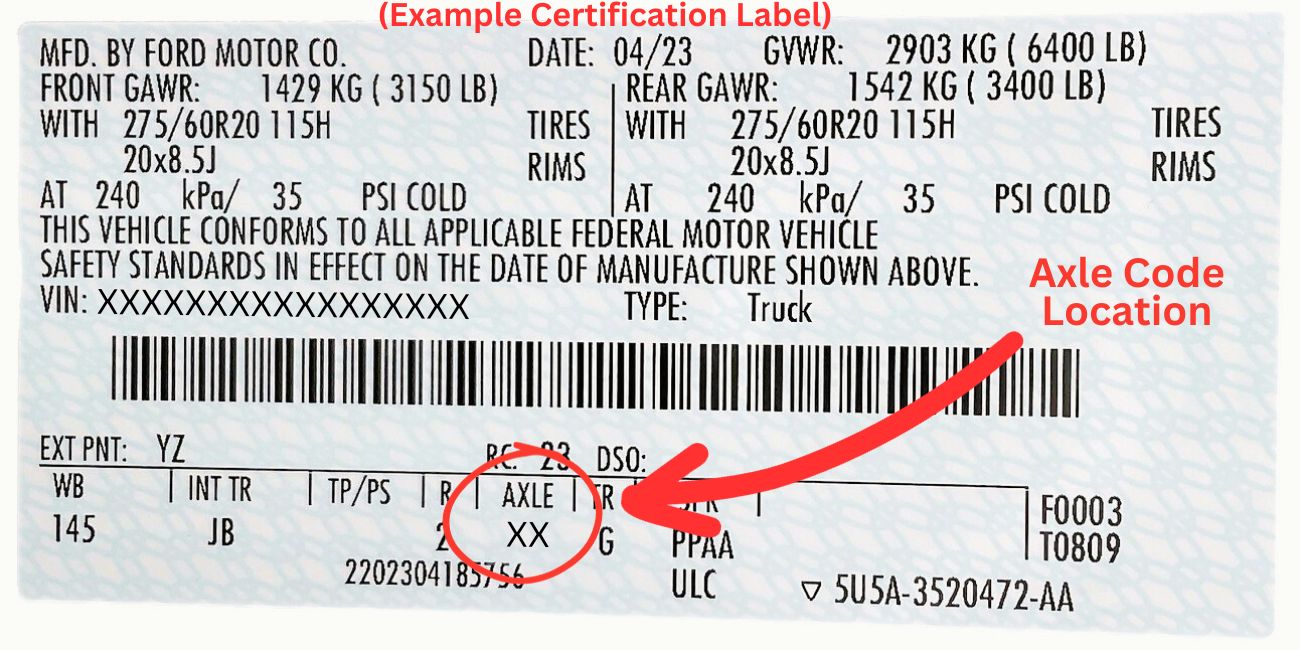Determining the towing capacity of your 2003 Ford Excursion is more complex than just glancing at the chart and saying, okay, this is my rating. It requires a basic knowledge of three (specific) attributes about your SUV. This article will guide you through the process of identifying not only what these key details are, but how and where to find them. Let's get started!
2003 Ford Excursion Towing Chart
Here's the towing chart for the 2003 Ford Excursion, which was meticulously compiled with data sourced directly from Ford's (official) Towing Guide.
As you study the chart, you will see the three variables that I was talking about pop up, which are required if you want to figure out your towing capacity. What kind of engine is in your Excursion, whether it's the 2WD or 4WD model, and the kind of axle ratio need to be plugged in to get an accurate number. Once you know these details, you can easily find your specific rating from the chart.

2003 Excursion Towing Capacity Breakdown By Engine:
When you dive into the chart's details a bit, you’ll notice the tow capacity isn't a one-size-fits-all number, it actually changes depending on which of the three engines your SUV has equipped. So, let's sift through some of the data and compare the results to see what each engine has to offer...
- For the 2003 Excursions that had the 5.4L (V8) engine, the towing figures are the most conservative, having a towing capacity of 6,100-7,600 lbs. for 2WD models, while 4WD models had a rating of up to 7,200 lbs.
- Moving onto the 6.8L (V10) engine option, if you had a 2WD version, you can expect to see a towing capacity of between 10,000-11,000 lbs. and for 4WD variations, the range varied only slightly, offering a 9,600-11,000 lb. rating.
- Models that had the 7.3l (diesel) engine equipped had shared the best towing capacity ratings, coming in at 11,000 pounds for both the 2WD and 4WD versions of the SUV.
- The 6.0l (diesel) engine was also an option for the later half of the year, as it was replacing the 7.3l engine and it had a towing capacity of up to 11,000 pounds, for both 2WD and 4WD models, the same as the 7.3l engine.
Three Things You Need to Know About Your Excursion To Get Your Towing Capacity:
Just to make things clear, you will need to know only three things about your excursion in order to get the right capacity rating from the chart:
- The engine you have equipped
- If you have a 2WD or 4WD model
- The axle ratio
It seems simple, right? Just by having those three pieces of information, you can get your tow rating but figuring out where to find these can be a little trickier than you might think, so the next part of the article will explain a lot of this in more detail.
Figuring Out Your Equipped Engine, Drivetrain (2WD or 4WD) and Axle Ratio...
If you're scratching your head over the specifics of your Excursion, don't worry, this part of the article is designed just for you and I'm going to guide you through how to find these three things. Let’s dive in and get things rolling!
Engine & Drivetrain Options:
To find out what engine and drivetrain (2WD/4WD) configuration you have, all you need to do is plug your SUV's VIN into an online VIN decoder. Just grab your vehicle's VIN and put it into any decoder, and it will indicate the engine type and whether it's a 2WD or 4WD configuration.
This gives you two of the three crucial details you're looking for, in a single, easy to perform step!


Axle Ratio Options:
It may be a bit more challenging to determine the axle ratio for older vehicles (like these ones), but if you know where to look, it's not too difficult. It will just take a little more time and resources, on your part.
Option 1: Look for Your Certification Label
Your SUV (and most other cars out there) will typically have a certification label located somewhere on them that contains a wealth of valuable information that you can use to your advantage. Ford vehicles (in particular) often include an "axle code" on this label, which provides you insight on the axle ratio being utilized, if it's actually printed.
Label Location & Axle Code: You can typically find the certification label on the driver's door or somewhere along the pillar, in that same area, and will look similar to the image I have provided below. On the bottom of the label, you'll notice the word "AXLE" and a code beneath it. In order to determine your axle ratio, you'll need to decode that "axle code".

Typically, Ford offers a table of sorts, in order to decode these "axle codes", but for some older vehicle models, this table seems to be missing. Instead, you will need to decode the "axle code" on your own and if you have to go that route, I suggest using a search engine to assist you.
If the axle code is not visible on your certification label or if the label is missing or severely faded, you will need to take a different approach (options 2 and 3).
Option 2: Take a Look for Yourself
The process of determining the axle ratio (by yourself) involves physically getting under the vehicle and looking for a metal tag, located somewhere on the rear axle housing. This method requires a certain level of mechanical knowledge and the willingness to get your hands dirty though, and is probably not an option for everyone.
If you happen to find this metal tag, it will display the axle ratio, along with other details, stamped right into it and for reference, the picture below illustrates the appearance of one of these tags (taken off the vehicle). The tag in this example indicates a 3.73 ratio, while the "L" in the middle tells us that it is a Limited Slip type of axle, although it is not relevant to us, for what we're doing.

Option 3: Get Some Help
You also have the option to visit a dealership and seek out someone's help in determining the axle ratio of your vehicle. The staff in these types of places tend to possess the expertise to accurately identify this information and can conduct a visual inspection for you to get the information you need.
3 Different Hitches & Their Weight Limits:
When it comes to towing, the type of hitch you have plays a crucial role in determining the weight restrictions and overall towing capacity. There are three main types of hitches commonly used for the 2003 Excursion and these are: a bumper hitch, a frame-mounted receiver hitch, and a weight distributing hitch.
- Bumper Hitch: A bumper hitch is the most basic type of hitch and can be found on different types of vehicles. It consists of a ball, that is literally screwed into the rear bumper of the vehicle and the trailer is then attached to this ball. A bumper hitch has a maximum rating of up to 5,000 pounds for these SUVs.
- Hitch Receiver: A hitch receiver is typically mounted (using bolts) to the vehicle's frame, which is the preferred choice for most people and the most common type of hitch that is used.
These bolts are incredibly sturdy and can withstand tremendous pressure, ensuring a robust connection, but it's important to note that the maximum rating on the chart is only 5,000 pounds and if you need to obtain those higher ratings (indicated in the tow chart), you must use a weight distributing hitch, along with a hitch receiver. - Weight Distributing Hitch: In order to achieve the highest ratings that we saw in the chart, a weight distributing must be used (alongside a hitch receiver) to evenly distribute the weight of the trailer, ensuring stability and enabling you to tow heavier loads. Ford mandates the use of a weight distributing hitch for loads that will exceed 5,000 pounds.

In order to ensure the accuracy and reliability of the information found in this article, I made sure to gather data from credible sources. These sources, include the 2003 Ford Towing Guide and the owner's manual, which I recommend you checking out for yourself, to get a better idea of your SUV's capabilities and limitations.
